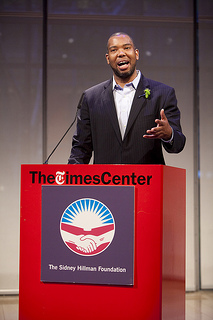
Steven Brill has won the March Sidney Award for his explanatory reporting on the high cost of medical bills. Brill’s prize-winning story, entitled “Bitter Pill: Why Medical Bills are Killing Us” was published as a special feature in Time, the longest in the magazine’s history.
Many of Brill’s core concepts, like the bargaining power of Medicare to secure low rates, and the higher prices charged to uninsured patients, will be familiar to health care policy wonks. What makes Brill’s piece stand out is they way he weaves the stories of real patients into a multi-faceted, systemic analysis of the high cost of medical care.
Brill spent seven months combing through medical bills in an attempt to discover what Americans will get for the estimated $2.8 trillion we will spend this year on health care. What he found blew away his preconceptions about why hospital bills cost so much. The culprits weren’t greedy health care unions or overly-entitled patients. The problem turned out to be the structure of the marketplace itself.
Brill describes the medical marketplace as a kind of Through the Looking Glass parody of the free market where uninsured patients are charged whatever the hospital sees fit, for whatever services they are deemed to need. Unlike public and private insurers, who negotiate fees for services in advance, and use their bargaining power to secure lower prices, the average uninsured patient is completely at the mercy of the system. If a hospital wants to charge $1.50 for a single generic Tylenol, or $6 for a paper cup, the patient has no way of knowing in advance and little standing to complain after the fact.
One 64-year-old woman was charged over $20,000 for a single ER visit. She thought she was having a heart attack, but it turned out to be indigestion. If the woman had been a year older, and enrolled in Medicare, the same care would have cost a fraction of what the woman was forced to pay.
Many investigative journalists have documented how non-profit hospitals are raking in even larger profits than their for-profit counterparts. Brill extends that analysis to see what non-profit insurers do with all this money, given that they can’t redistribute it to shareholders, like for-profit hospitals do. Instead of devoting the surplus to charity care, as one might expect from non-profit hospital, these institutions reinvest in ever larger buildings and ever more elaborate testing machines. Many also pay their top administrators exorbitant salaries.
Studies show that the more machines there are, the more tests doctors tend to order. Brill notes that there’s an even bigger conflict of interest when the hospital or the doctor owns the machine and sets the price for using it. Hospitals that own their own diagnostic machines and testing facilities have a vested interest in charging high fees for these tests, and testing a lot of people who may or may not need them. The end result is a vicious cycle of overcharging and over-treatment.
Brill shies away from sweeping policy recommendations, and he has said in interviews that he thinks single-payer health care is not a realistic option of the United States, but the implications of his argument are difficult to escape. Lone patients are the worst off when it comes to medical gouging. Private insurers fare significantly better, but their bargaining power pales compares to that of Medicare. If Medicare can secure such dramatically lower rates because of its immense bargaining power, why not put everybody on Medicare?
The depth and scope of Brill’s reporting makes Bitter Pill an important contribution to the national debate on health care costs and its prominent placement in Time will familiarize a broad cross-section of the public with critical concepts that policy wonks have been laboring to disseminate for years.







